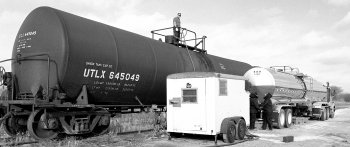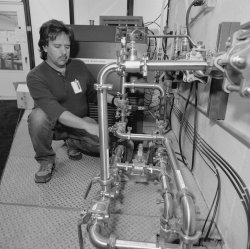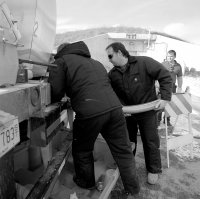 |
|
A Clear View by Kurt Riesselmann
It is as translucent as glass. It comes by train, two railcars every week. Fermilab will receive 250,000 gallons of it, enough to fill a 25-meter swimming pool.
What is it?
Some of the clearest mineral oil available in the country, intended for the MiniBooNE experiment.
“It is crystal clear,” said physics professor Randy Johnson, who has overseen the selection process of the oil. “It’s much clearer than water that comes out of your faucet.”
Johnson, who teaches at the University of Cincinnati, is one of 60 scientists working on MiniBooNE, an experiment designed to unravel the mysterious properties of tiny ghost-like particles called neutrinos. Until 1998, physicists believed that neutrinos are massless particles. Since then a few experiments have shattered this dogma by reporting results that indicate neutrinos do have a mass after all.
Understanding these surprising neutrino phenomena has become a top priority for particle physicists around the world. The MiniBooNE collaboration will study man-made neutrinos, created by Fermilab’s accelerators. A spherical steel tank, 12 meters (40 feet) in diameter and equipped with 1,500 light sensors, represents the heart of the MiniBooNE neutrino detector. When filled with oil, the detector will record the interaction of neutrinos with oil molecules, a process that leads to flashes of blue light. To observe the light pattern with maximum intensity and minimum distortion, experimenters rely on ultraclear oil.
“Oil companies have a very specific list of requirements for mineral oil used for baby or cooking oil, for example,” explained Johnson. “Our requirements for clear oil exceed theirs.”
For the MiniBooNE experiment to work well, scientists require the oil to have an attenuation length of greater than 20 meters, which means that at least 90 percent of the light sent into a two-meter-thick sample of oil emerges at the opposite end.
To find the right vendor with the best oil for the experiment, Johnson initiated a nation-wide bidding process in which oil distributors submitted samples of their oil. Graduate student Jennifer Raaf and postdoc Eric Hawker, both members of Johnson’s research group, determined the light transmission properties of each sample as a function of length, using various shades of blue light.
“Ten different bids came in, each submitted with a ten-gallon sample,” said Raaf. “Many samples had an attenuation length of 15 meters. The worst was 2 meters. The oil that we chose has a 26-meter attenuation length.”
In December the first two railcars with 46,000 gallons of oil arrived at Fermilab, paid for by a National Science Foundation grant to Columbia University. Fermilab’s Jesse Guerra and his group of technicians were ready.
“We’ve been involved with the MiniBooNE experiment from the start,” said Guerra. “We’ve cleaned the inside of the detector tank and helped with the installation of the photomultiplier tubes. For the oil pumping station at the railhead, we’ve done everything from engineering to producing blueprints to fabrication.”
This is the first time that Fermilab has received oil by rail. Setting up the right infrastructure is only part of the challenge. Keeping the oil clean is as much of a concern.
“We have to use food-grade clean pipes, railroad cars and trucks,” explained Guerra. “The railcars need to be cleaned to our specifications.”
To minimize the amount of contaminants entering the oil inside the detector tank, Andrew Bazarko, scientist at Princeton University, carried out a series of tests by putting various detector materials, such as rubber, epoxy and paint, into samples of oil and heating them to 140 degrees Fahrenheit for eight hours. Finding the right material for the 30 miles of electrical cable, which connect the light sensors inside the oil-filled detector tank with the external data acquisition system, was critical. The MiniBooNE scientists decided to use Teflon-coated cables to keep the oil clear.
So far technicians have pumped more than 40,000 gallons of oil into the MiniBooNE detector.
“The highlight was before Christmas,” said Guerra. “We started pumping oil into the detector. It was a great Christmas gift for us.”
It will take about six weeks to fill the detector tank. Scientists will then begin to test their new detector using cosmic rays. In May the first accelerator-made neutrinos will cross the detector.
“We are scheduled to operate for two years,” said Johnson. “It depends on what we find whether we will operate longer.”
The MiniBooNE detector should soon make that perfectly clear.
MiniBooNE homepage
|

 Oil by the carload
Oil by the carload
 “We are concerned about two types of contaminants,” said Hawker, who together with Raaf monitors the quality of the shipped oil. “We watch for chemical contaminants, such as water and plastic; and particulates: little specks of dirt, dust or paint, smaller than the thickness of a human hair. They all reduce the attenuation length. Even worse, they might scintillate, creating sparks of light on their own.”
“We are concerned about two types of contaminants,” said Hawker, who together with Raaf monitors the quality of the shipped oil. “We watch for chemical contaminants, such as water and plastic; and particulates: little specks of dirt, dust or paint, smaller than the thickness of a human hair. They all reduce the attenuation length. Even worse, they might scintillate, creating sparks of light on their own.”